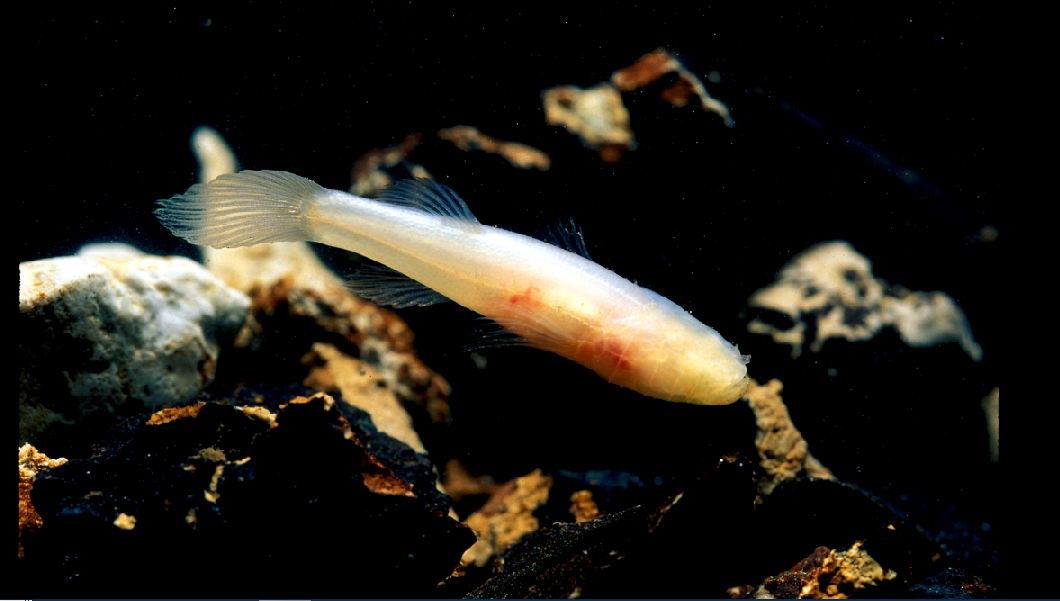How to Find the Ghost
The Ozark cavefish is about a pointer finger long, 2.25 inches, in adulthood (Noltie and Wicks, 2001). Many people have nick-named this tiny fish as the ghost fish because of its nearly transparent whitish to light pink coloring (Handwerk, 2003, and USFWS, 2013). The only color that is visible in this fish is the circulatory system or the body cavity organs (Adams and Johnson, 2001). This organism is described as having a protruding jaw and a rounded fin (MDC, 2014). Although the Ozark cavefish is small, this fish have the average life span of about fifteen years (ODOWC, 2011). The Ozark cavefish has no eyes (Handwerk, 2003). The cavefish back tail, used for swimming, is rounded, not like the common sharp fish tail (MDC, 2014). It also either lacks or has reduced pelvic fins that are typically found in the fish (Adams and Johnson, 2001).
 Living in
the dark cave environment in the
Ozark Plateau
(MDC, 2014), the cavefish has many physical adaptations to increase their
success of survival. One adaption is the loss of eyes (Handwerk,
2003). The eyes are used to capture light and see colors in most organisms; but
the Ozark fish living only in caves and underground water, as stated in the
habitat will have little to no light exposure, having no
use for it when they are always in total darkness. Another adaptation of the
Ozark cavefish is the coloration (MDC, 2007). Because there is no light
anyway, there is no need for colors as well. This fish species does not have
to camouflage from its predators (MDC, 2007). Having a tail and swimming
fins, they swim around like
other fish species. What makes
them unique
is that on the tail, fins and head, the Ozark fish have developed sensory
organs in place of eyes (Handwerk, 2003). These
sensory organs are used to
sense water movement to notify this organism of potential
prey or mate and changes in the chemical composition in the environment (Handwerk,
2003 and USFWS, 2013).
Living in
the dark cave environment in the
Ozark Plateau
(MDC, 2014), the cavefish has many physical adaptations to increase their
success of survival. One adaption is the loss of eyes (Handwerk,
2003). The eyes are used to capture light and see colors in most organisms; but
the Ozark fish living only in caves and underground water, as stated in the
habitat will have little to no light exposure, having no
use for it when they are always in total darkness. Another adaptation of the
Ozark cavefish is the coloration (MDC, 2007). Because there is no light
anyway, there is no need for colors as well. This fish species does not have
to camouflage from its predators (MDC, 2007). Having a tail and swimming
fins, they swim around like
other fish species. What makes
them unique
is that on the tail, fins and head, the Ozark fish have developed sensory
organs in place of eyes (Handwerk, 2003). These
sensory organs are used to
sense water movement to notify this organism of potential
prey or mate and changes in the chemical composition in the environment (Handwerk,
2003 and USFWS, 2013).
Although the Ozark have limited adaptation, some unique characteristics about the Amblyosidae family trait for adapting to the subterranean life are small size, infrequent reproduction, long lifespans, low metabolic rates, and small population sizes (Noltie and Wicks, 2001).
Next find out more about how the ghost interact with other organsims on the interaction page. For more information about the living environment of the Ozark cavefish, check out the habitat!
<<Habitat Homepage Interaction>>